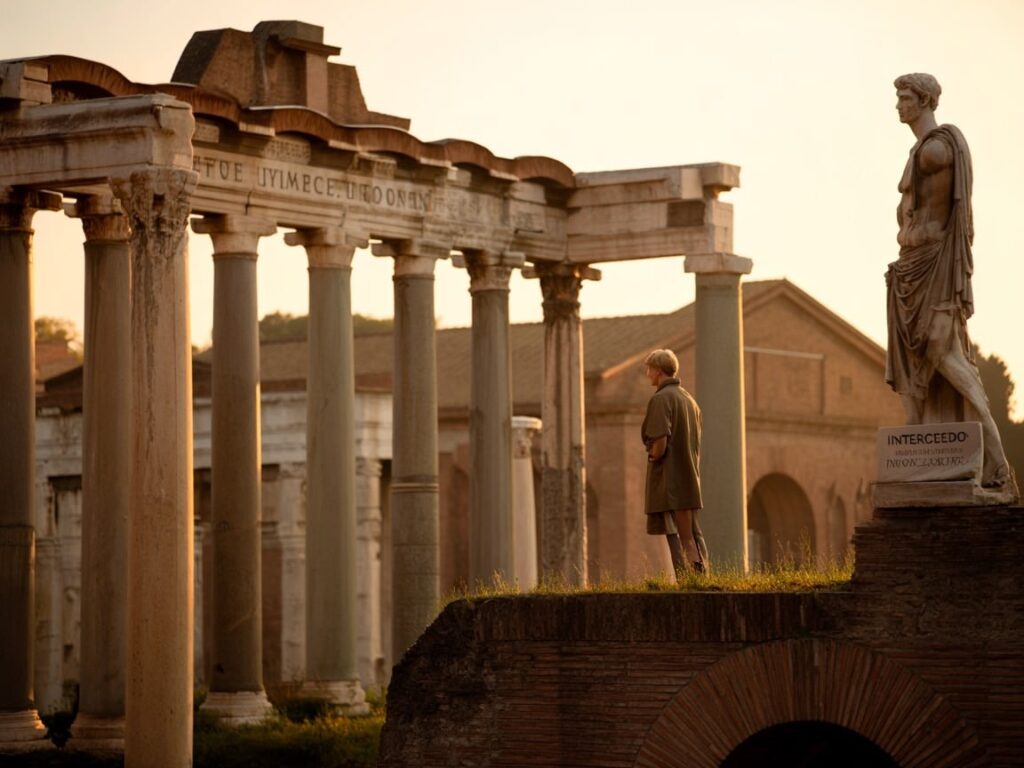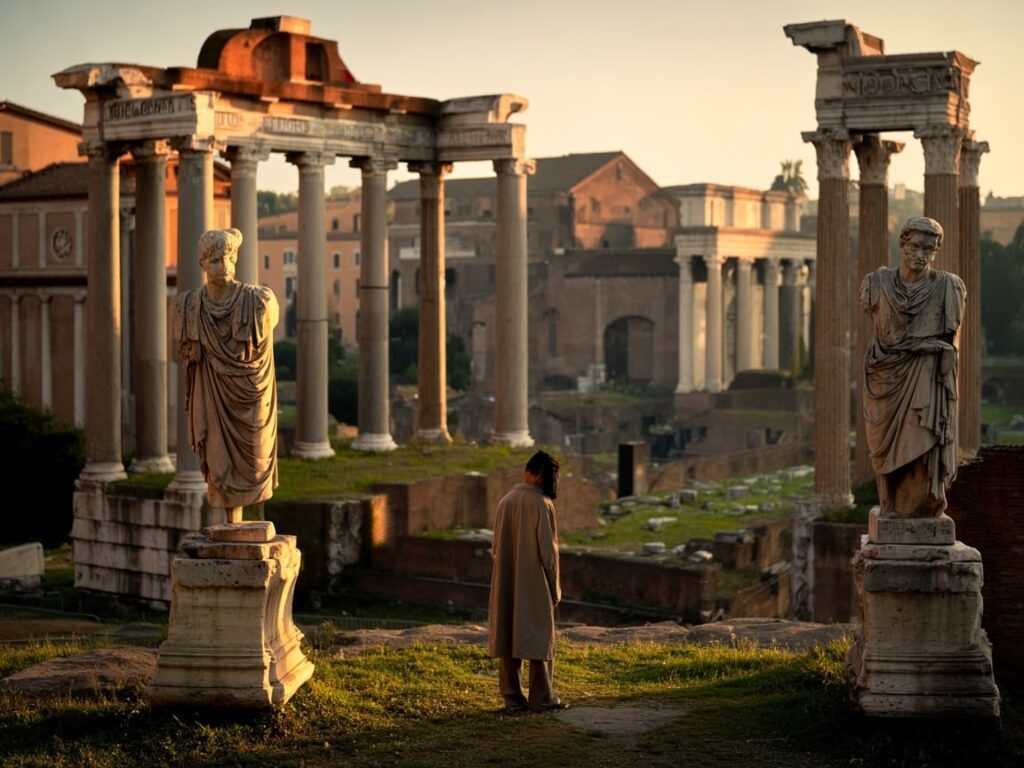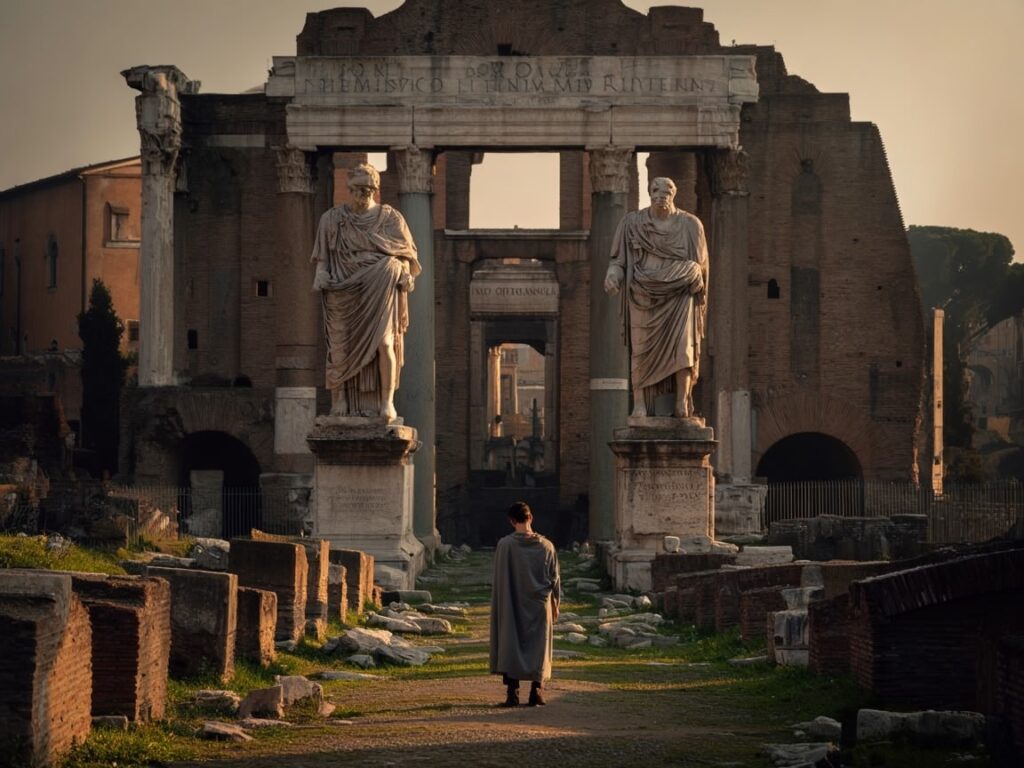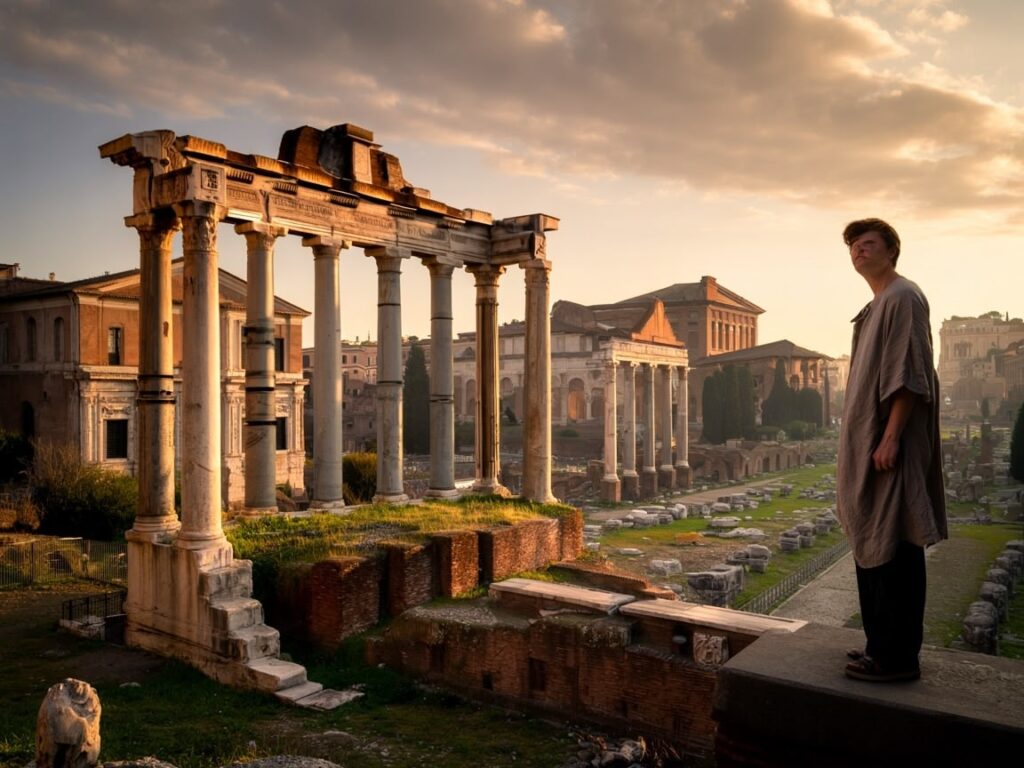Discover the forgotten constitutional mechanisms that powered Rome’s 500-year republic and continue to influence modern governance. Learn how the balance between patricians and plebeians created a remarkable system of checks and balances that modern democracies still emulate today.
Standing in the Roman Forum today, surrounded by crumbling columns and fragmented marble, it’s easy to forget that these ruins represent what was once the most successful republic in human history. While modern democracies measure their stability in decades, Rome’s republican experiment lasted for nearly five centuries. The secret to this extraordinary longevity has been hiding in plain sight, embedded in constitutional innovations that continue to shape our world.
What made Rome’s republic exceptional wasn’t its initial design—it was its ability to evolve. Unlike the fixed constitutions we venerate today, Rome’s governing structure constantly adapted through an ongoing negotiation between social classes. This tension between patricians and plebeians—rather than destroying the republic—became its greatest strength, creating a dynamic system of checks and balances that prevented any single faction from dominating the state.
This constitutional flexibility stands in stark contrast to many modern democracies, where partisan gridlock and institutional rigidity have become defining features. Today’s political systems frequently find themselves paralyzed by polarization, unable to address fundamental challenges. The Roman model offers surprising insights for our contemporary struggles, revealing how conflict, properly channeled, can strengthen rather than weaken democratic institutions.
The Myth of Rome’s Perfect Constitution
When we imagine ancient Rome, we often picture a perfectly designed republic—a marble monument to political wisdom. This idealized vision couldn’t be further from the truth. Rome’s governance system began as a reactionary response to the overthrow of monarchy around 509 BCE, with patrician elites hastily constructing institutions to maintain their power while placating the masses. The early republic was profoundly undemocratic by modern standards, with political rights severely restricted and wealth concentrated in the hands of a small aristocracy.
The genius of Rome wasn’t creating a perfect system but developing mechanisms to peacefully resolve class conflict. When plebeians (the common citizens) felt their interests were being ignored, they didn’t merely complain—they organized. The famous “secession of the plebs” in 494 BCE saw Rome’s common citizens simply walk out of the city, effectively going on strike against the patrician-controlled government. Rather than responding with force, Rome’s elites negotiated, establishing the office of the Tribune of the Plebs—representatives with veto power over any legislation.
This pattern would repeat throughout Republican history. Moments of crisis that might have destroyed other political systems instead became opportunities for constitutional evolution in Rome. This capacity for adaptation—not any inherent perfection in its original design—explains how Rome maintained republican governance for five centuries while most modern democracies struggle to maintain institutional stability for even a fraction of that time.

The Tension That Preserved Liberty
The most counterintuitive aspect of Rome’s success was how it transformed class conflict from a destructive force into a constructive one. Modern political discourse often treats societal division as inherently problematic—something to be minimized or eliminated. The Romans took a different approach, institutionalizing conflict through a complex system of checks and balances that prevented any single group from accumulating unchecked power.
At the heart of this system was the concept of collegiality—the principle that important offices should be held by multiple people simultaneously, each with the power to veto the others. The two consuls who jointly led the republic exemplified this approach. Though both possessed immense authority, including command of armies, each could block the other’s actions. This built-in limitation prevented the consolidation of power that so often leads to tyranny.
Perhaps even more remarkable was the Tribune of the Plebs, an office specifically designed to represent the interests of common citizens against the patrician elite. Tribunes could veto virtually any government action with a single word: “Intercedo” (I intercede). Their persons were declared sacrosanct—to harm a tribune was a capital offense. This gave common citizens meaningful representation in a system otherwise dominated by wealth and lineage.
These institutional innovations created what political scientists would now call “veto players”—entities whose agreement was necessary for policy change. By distributing veto power across social classes, Rome ensured that major decisions required broad consensus. This arrangement prevented both tyranny of the majority and domination by elites, creating a system where compromise became essential to governance.
The Constitutional Innovation You’ve Never Heard Of
While modern students of democracy focus on Rome’s familiar institutions like the Senate, the most revolutionary aspect of Roman governance remains largely overlooked: the mixed constitution. Roman political thinkers like Polybius recognized that their system combined elements of monarchy (consuls), aristocracy (Senate), and democracy (popular assemblies). This hybrid approach allowed Rome to capture the strengths of each form while mitigating their weaknesses.
The mixed constitution worked because it acknowledged a fundamental truth: different social classes have different interests that deserve representation. Rather than pretending these differences didn’t exist or could be eliminated, Rome built a system that formalized class interests through distinct institutions. The Senate represented the patrician perspective, while the various popular assemblies and tribunes advocated for plebeian concerns.
This arrangement created multiple pathways for citizens to participate in governance based on their status and concerns. A wealthy patrician might exercise influence through the Senate, while ordinary citizens could address grievances through the Plebeian Assembly or appeal to their tribunes. By providing multiple channels for political participation, Rome avoided the winner-takes-all mentality that characterizes many modern systems.
Even more remarkably, this approach evolved to include what we might now call a separation of powers. Different magistrates held different types of authority, and each major decision required approval from multiple bodies. Laws had to pass both senatorial review and popular assembly votes. Military commands required senatorial authorization and popular approval. This diffusion of power prevented any single faction from controlling all aspects of governance.

When the Unwritten Constitution Matters More Than the Written One
Perhaps the most relevant lesson from Rome for modern democracies lies in understanding the importance of unwritten constitutional norms. While we obsess over the text of constitutions, much of Rome’s success stemmed from unwritten traditions that governed political behavior—what Romans called the mos maiorum, or “way of the ancestors.”
These unwritten rules established expectations for how political actors should behave even when formal constraints were absent. Roman politicians understood that certain actions, while technically legal, violated traditional norms and would trigger public backlash. The shame of being seen as undermining republican traditions served as a powerful check on ambitious politicians.
Consider the tradition of consulting the Senate before major decisions. Consuls weren’t legally required to seek senatorial approval for many actions, but failing to do so violated long-established custom and would damage a politician’s reputation. Similarly, using violence to achieve political ends was considered fundamentally un-Roman, even when no specific law prohibited it.
The stability of the republic depended on these shared values as much as on formal institutions. When these norms began to erode in the late republic—when politicians like Tiberius Gracchus and Sulla began ignoring traditional constraints—the constitutional system rapidly deteriorated. The lesson for modern democracies is clear: written rules alone cannot sustain democratic governance without shared commitment to underlying principles.
The Class Struggle That Strengthened Rome
The most fascinating paradox of Roman governance was how class conflict, rather than undermining the republic, strengthened it for centuries. The “Struggle of the Orders”—the ongoing tension between patricians and plebeians—produced a series of constitutional compromises that gradually expanded rights and created more inclusive institutions.
When plebeians demanded access to the consulship, patricians initially refused outright. After prolonged social pressure, a compromise emerged: the creation of military tribunes with consular power, positions open to both classes. Later, the Licinian-Sextian laws guaranteed that one consul would always be a plebeian. Similar compromises opened priesthoods, expanded voting rights, and reformed debt laws.
These hard-won concessions didn’t represent the collapse of the system but its evolution. Each compromise incorporated more citizens into governance while preserving essential republican features. The patricians retained significant influence through the Senate, while plebeians gained meaningful avenues for participation and protection. This evolutionary approach allowed Rome to adapt to changing social conditions without revolutionary upheaval.
Modern democracies might learn from this approach to class tensions. Rather than viewing social conflict as evidence of democratic failure, the Roman example suggests that properly channeled class struggle can lead to more resilient and representative institutions. The key lies in creating systems where competing interests can negotiate peaceful compromises rather than winner-takes-all confrontations.

Why Rome’s Republic Eventually Fell (And What It Teaches Us)
No discussion of Rome’s republican success would be complete without acknowledging its ultimate failure. After nearly five centuries, the republic collapsed into dictatorship and empire. This transition offers crucial insights for contemporary democracies facing their own institutional challenges.
The conventional explanation for Rome’s republican collapse emphasizes the role of ambitious individuals like Julius Caesar. While such figures certainly accelerated the republic’s demise, focusing solely on personalities misses the deeper institutional failures that made their rise possible. The republic didn’t fail because of Caesar; Caesar was possible because the republic had already failed.
Three critical factors undermined Rome’s constitutional balance. First, unprecedented military expansion created armies loyal to generals rather than the state. As Rome conquered the Mediterranean, proconsuls commanded forces far from Rome for years, developing personal loyalties that transcended institutional allegiance. When Pompey or Caesar called, soldiers answered to the man, not the republic.
Second, extreme inequality eroded the middle class that had formed the republic’s backbone. As wealth concentrated among a small elite, many citizens became economically dependent on powerful patrons. This clientage system undermined the independence necessary for republican citizenship, transforming the political process into competition between rival networks rather than debate over public good.
Finally, political violence shattered the norms that had sustained republican governance. When Tiberius Gracchus was murdered in 133 BCE—the first political assassination in Rome in nearly four centuries—it broke the taboo against lethal force in politics. Once violence became an acceptable political tool, constitutional methods of resolving disputes lost their authority.
The lesson for modern democracies is sobering. Constitutional systems don’t typically fail through frontal assault but through gradual erosion of the norms and conditions that sustain them. Economic inequality, polarization, and the normalization of constitutional hardball can undermine democratic governance long before formal institutions collapse.
Rome’s Republican DNA in Modern Constitutions
While Rome’s republic eventually failed, its constitutional innovations live on in virtually every modern democratic system. The American founding fathers drew extensively from Roman examples, incorporating checks and balances, separated powers, and bicameral legislatures into their constitutional design. Even the term “senate” comes directly from Rome’s governing council.
The Roman influence extends far beyond America. Modern concepts like the veto, term limits, and balanced government all have Roman origins. The principle that different social interests deserve institutional representation—embodied in various forms of proportional representation—echoes Rome’s mixed constitution. Even the modern idea of constitutional courts can trace intellectual lineage to Rome’s complex legal system.
Perhaps the most enduring Roman contribution is the very concept of a republic—a system where power belongs to the people and is exercised through representatives constrained by law. The Latin phrase res publica literally means “public affair,” emphasizing that governance belongs to the community rather than to any individual or faction.
This republican ideal—that government should serve the common good rather than narrow interests—remains the standard against which we judge our political systems. When we criticize corruption, special interest influence, or the concentration of power, we’re invoking standards that would have been familiar to Cicero or Cato.

The Forgotten Lessons for Today’s Democracies
As modern democracies face mounting challenges from polarization, inequality, and institutional rigidity, Rome’s republican experience offers valuable insights that have been largely forgotten. Three lessons stand out as particularly relevant to our contemporary situation.
First, constitutional systems require flexibility to survive. Rome’s republic endured for centuries because it could adapt to changing social conditions without abandoning core principles. Modern democracies often treat their constitutions as sacred texts rather than living frameworks, creating rigidity that makes peaceful evolution difficult. The Roman example suggests that the ability to reform institutions in response to new challenges is essential for democratic longevity.
Second, class conflict can strengthen democracy when properly channeled. Rome’s constitutional development was driven by the tension between patricians and plebeians, with each crisis producing innovations that made the system more inclusive and resilient. Rather than fearing political conflict, modern democracies might focus on creating institutions that transform social tensions into constructive pressure for reform.
Finally, unwritten norms matter as much as formal rules. Rome’s republic didn’t collapse because its constitutional structure was flawed but because the norms that governed political behavior broke down. When politicians began prioritizing faction over republic and employing any means necessary to achieve their ends, no constitutional mechanism could preserve the system. Modern democracies would do well to remember that democratic institutions depend on shared commitment to democratic values.
Reimagining Constitutional Balance for the 21st Century
The true genius of Rome’s republic wasn’t any particular institution but the balance it maintained between competing social forces. This dynamic equilibrium—patricians and plebeians, Senate and popular assemblies, tradition and reform—created a system resilient enough to endure for five centuries despite enormous challenges.
Modern democracies struggle to achieve similar balance. Many systems oscillate between periods of gridlock and partisan dominance, with neither state producing sustainable governance. Power concentrates in unaccountable institutions while citizens feel increasingly disconnected from decision-making processes. The result is growing disillusionment with democratic governance itself.
Addressing these challenges requires creative thinking about constitutional design. How might we create systems that balance efficiency with deliberation, majority rule with minority rights, stability with adaptability? The Roman example suggests looking beyond formal structures to the underlying social contract—the implicit agreement about how power should be distributed and exercised.
Perhaps the most valuable insight from Rome’s republican experiment is that constitutional systems work best when they acknowledge and accommodate social divisions rather than pretending they don’t exist. By creating institutions that gave different groups meaningful voice while forcing compromise, Rome transformed potentially destructive conflicts into a source of resilience.
As we face our own democratic challenges, we would do well to remember this lesson. The path to more stable and responsive governance may not lie in overcoming our differences but in creating systems that can harness them productively—just as Rome did for five remarkable centuries.
The Republic We Could Build
Rome’s 500-year republic wasn’t perfect. It excluded many from participation, tolerated slavery, and eventually succumbed to imperial rule. Yet its longevity and influence testify to the remarkable achievement of its constitutional balance. By transforming class conflict into institutional compromise, Rome created a system that distributed power broadly enough to prevent tyranny while maintaining sufficient unity to govern effectively.
The challenge for modern democracies is to achieve a similar balance while addressing contemporary issues Rome never faced—mass participation, complex economies, technological change, and global interdependence. This requires not slavish imitation of Roman institutions but creative adaptation of Roman principles to modern conditions.
What might this look like in practice? Perhaps developing new forms of citizen participation that go beyond periodic voting. Perhaps creating institutional representations for interests currently excluded from political processes. Perhaps establishing stronger constitutional norms against the winner-takes-all approach that increasingly dominates democratic politics.
The specific solutions will vary by context, but the fundamental insight remains constant: constitutional systems thrive when they balance competing forces rather than allowing any single faction to dominate. Rome achieved this balance through centuries of negotiation between patricians and plebeians. Our task is to find contemporary equivalents that can sustain democratic governance through the challenges ahead.
Rome’s republican experiment offers both inspiration and warning. It demonstrates that self-government can endure for centuries even amid profound social divisions. It also reminds us that even the most successful republics remain vulnerable when their constitutional foundations erode. As we navigate our own democratic challenges, we would do well to rediscover the forgotten wisdom that kept Rome’s republic alive for 500 remarkable years.

